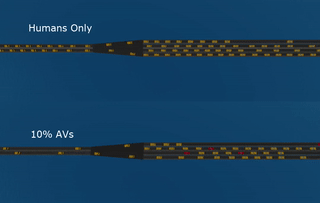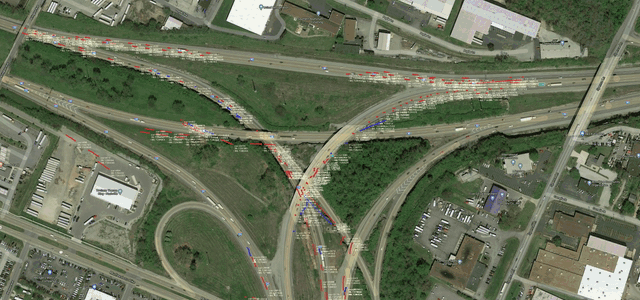
The Congestion Impacts Reduction via CAV-in-the-loop Lagrangian Energy Smoothing (CIRCLES) project aims to improve traffic flow and reduce energy consumption using deep reinforcement learning and self-driving cars.
There are two control objectives in the expriment:
1. Save fuel consumption by optimizing the speed profile of vehicles to smooth out the density shockwave in traffic flow.

2. Improve traffic throughput at the bottlenecks by control the density using controlled AVs as macro flow regulators.


Objective II: Bottleneck (left) Border Collie improve the throughput of sheepflow by controlling the sheep density at the bottleneck. In MVT, AVs will be our Border Collies. (right) Using AV as coordinator for bottleneck management. (Credit: FLOW Project)
As the final field test of CIRCLES, the MegaVanderTest (MVT) was conducted on a 14.5-km stretch of Interstate I-24 in Nashville, Tennessee. This large-scale traffic experiment deployed a fleet of 100 automated vehicles to explore the practical application of the hierarchical Speed Planner framework, which integrates server-side algorithms with vehicle-side execution to manage variable speed limits in mixed autonomy traffic environments.

The hierarchical Speed Planner introduced in this study focuses on enhancing traffic flow, reducing congestion, and improving fuel efficiency. It achieves this by combining macroscopic traffic data from sources like INRIX with microscopic observations from controlled vehicles. The Traffic State Estimation (TSE) module within the planner enhances real-time traffic data, and the Target Speed Design module generates optimal speed profiles for vehicles, aiming to smooth traffic waves and mitigate bottlenecks.
During the MVT, the Speed Planner demonstrated notable improvements in traffic management. The field test results show an overall 8% traffic density decrease, with a specific decrease of 7% upstream, 10% downstream, and a 52% decrease during the congestion formation phase at bottlenecks.